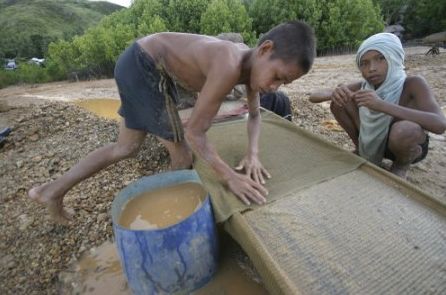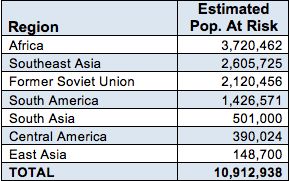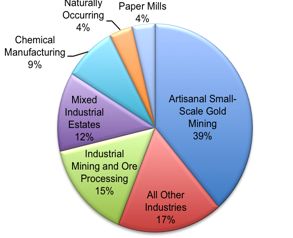Updated 2019

Child gold miners in Indonesia
It has been over 50 years since the first sign of mass mercury poisoning emerged in Minamata, Japan.
Cats in the village started staggering and tilting, doing a strange “dancing cat fever.” Then people started acting the same way.
The Minamata Convention on Mercury is the first global treaty to mitigate and prevent mercury pollution. It was signed by delegates from 128 countries in 2013. As of 2019, the Minamata Convention on Mercury has reached 105 ratifications.
This international agreement is a step in the right direction because mercury affects everyone, and requires a global approach to solve. Here are some facts and figures about toxic mercury that might surprise you.
FACTS:
- Mercury travels – When released, mercury rises into the atmosphere and can travel long distances, contaminating oceans and rivers worldwide. Mercury builds up in the bodies of certain fish as methylmercury – the reason why pregnant women worldwide are often told to avoid eating certain seafood.
- Mercury lingers – It takes decades or even centuries for toxic mercury to cycle through the environment. It transfers back and forth between soil and water and the atmosphere over the years.
- Mercury is one of the top six toxic threats, and is considered one of the top ten chemicals of major public health concern by WHO.
- Mercury is especially devastating to children. Its damage is irreversible. Even in small amounts, mercury may cause serious health problems. According to the WHO, mercury threatens the development of infants in utero and disrupts the physiological and neurological development of children. It attacks the central nervous system and several organs, and in higher doses, it can kill.
- Artisanal and small-scale gold mining is “… responsible for the largest releases of mercury to the environment of any sector globally.” Around the world, artisanal and small-scale gold miners work under few regulations to make a meager living, using toxic mercury to extract gold from tiny bits of ore.
- Artisanal gold mining is responsible for over 30% of the world’s mercury emissions – about 1,400 tons of toxic mercury released per year. The United Nations Environment Programme estimates that artisanal and small-scale gold mining (ASGM) is responsible for over 700 tonnes per year of mercury emissions to the atmosphere and an additional 800 tonnes per year of mercury releases to land and water, making it the largest anthropogenic source of mercury.
- About 10 to 25 percent of the world’s total gold supply comes from artisanal gold mining.
- 4.5 million women and 600,000 children are among some 10-15 million artisanal gold miners being poisoned by direct contact with toxic mercury.
FIGURES:
While mercury travels and affects people worldwide, the problem is most acute in certain hotspots.
- 425: Number of sites worldwide contaminated by mercury*
- 10.9 Million: Number of people at risk from these sites*
Pie chart: Percentage of total population at risk from mercury by pollution source industry (*data from Pure Earth’s Toxic Sites Identification Program, as of Oct 2013)
WHAT IS BEING DONE:
- Global treaty – The Minamata Convention will help work towards a reduction in worldwide mercury emissions. One provision requires countries to devise national action plans to help limit and control artisanal and small-scale gold mining.
- Global alliance – The GAHP (Global Alliance on Health and Pollution), supported by the World Bank, the Asian Development Bank, the European Commission and UNIDO, among other agencies, and for which Pure Earth serves as Secretariat, is the first alliance of its kind to respond to the threat of toxic pollution on a worldwide scale. Any low or middle-income country can approach the GAHP for help to reduce mercury emissions (or solve other toxic pollution problems). To seek GAHP help or learn more, contact the GAHP Secretariat at [email protected].
- Various initiatives are being explored around the world. Pure Earth’s Global Mercury Program has:
- Trained thousands of artisanal gold miners worldwide in safe and profitable mercury-free techniques
- Educated miners and their families, communities, health workers, government stakeholders and others about mercury risks;
- Launched initiatives to empower women miners and help them earn more money with mercury-free gold
- Begun reforestation of 3.5 hectares of rainforest stripped by gold mining in the Amazon.
- Successfully used low-cost mercury retorts, which can recapture as much as 97% of the mercury released by miners. In early work in Indonesia, Pure Earth distributed 100 retorts and 70 water-box-condensers to the mining community, reducing mercury emissions by 4750 kgs annually.
- Identified and assessed hundreds of sites contaminated by mercury around the world through the Toxic Sites Identification Program so they be prioritized for cleanup.
Learn more:
Rainforest Reforestation Brings Degraded Mining Sites Back to Life, Provide Models of Hope
Meet The Maqques: A Family Of Gold Miners Going Mercury Free So They Can Work Together Safely
Transforming The Chichiqueros Gold Mining Community In Peru’s Rainforest Into A Mercury-Free Model
In Photos: Teaching Artisanal Gold Miners To Extract Gold Without Mercury
A Mother’s Story: Mongolian “Gold Ninja” Goes Mercury-Free For Her Children
Mongolia Teaching Van Trailblazes A Path To Mercury-Free Mining
- (VIDEO) Mercury: The Burning Issue – Gold mining in Indonesia (VIDEO) Mercury and Child Gold Miners in Indonesia
- (VIDEO) History of Minamata (by professor Jack Caravanos, School of Public Health, CUNY)
- Cleaning Mercury out of Indonesian Gold (Huffington Post)
- How Mercury is Destroying Indonesia (BBC News)
- The Surprising Source of Most Mercury Pollution (Live Science)
- Will the New Global Treaty be Effective?
- GAHP resource page on Chemicals and Toxins







